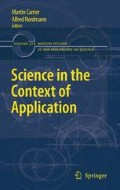Abstract
Recent work in the domain of the validation of complex computational models reveals that modelers of complex systems, particularly modelers of the earth’s climate, face a deeply entrenched form of confirmation holism. Confirmation holism, as it is traditionally understood, is the thesis that a single hypothesis cannot be tested in isolation, but that such tests always depend on other theories or hypotheses. It is always this collection of theories and hypotheses as a whole, says the thesis, that confront the tribunal of experience. But in contrast to the way the problem of confirmation holism is typically understood in the philosophy of science, the problems faced by climate scientists are not merely logical problems, and nor are they confined to the role of anything that can suitably be called auxiliary hypotheses. Rather, they are deep and entrenched problems that confront the scientist who works with models whose component parts interact in such a complex manner, and have such a complex history, that the scientist is unable to evaluate the worth of the parts in isolation
Access this chapter
Tax calculation will be finalised at checkout
Purchases are for personal use only
Notes
- 1.
The word “attribution” also occurs in the prominent phrase “attribution of climate change” which stands for the question whether observed climatic change is caused by humans. We do not use the word in this way in this paper.
- 2.
“Appropriate” in the sense that, for the intended purpose of the model, the model is close enough to the world in the intended respects and to the intended degree of accuracy.
- 3.
The first version of Quine’s article (1951) did not mention Duhem.
- 4.
We are aware of the fact that this claim has some plausibility at the current point but not certainty. The latter calls for a more thorough historical-philosophical study.
References
APE. 2008. Website of the Aqua-Planet Experiment Project, visited Feb 4, 2008. http://www-pcmdi.llnl.gov/projects/amip/ape/index.html
Bogen, J., and J. Woodward. 1988. Saving the phenomena. The Philosophical Review 97(3), 303–352 (July).
Clark, A. 1987. The Kludge in the machine. Mind and Language2(4):277–300.
Duhem, P. 1954. The Aim and Structure of Physical Theory (trans. P. Wiener of La théorie physique son objet et sa structure, 2nd ed. Paris, Chevalier et Rivière, 1914). Princeton, NJ: Princeton University Press.
Edwards, P.N. 2001. Representing the global atmosphere: Computer models, data, and knowledge about climate change. In Changing the Atmosphere: Expert Knowledge and Environmental Governance, eds. C. Miller, and P. Edwards, 31–65. Cambridge, MA: MIT Press.
Gates, W.L., et al. 1999. An overview of the results of the atmospheric model intercomparison project (AMIP I). Bulletin of the American Meteorological Society 80:29–55.
IPCC. 2001. Contribution of Working Group I to the Third Assessment Report of the Intergovernmental Panel on Climate Change (IPCC), eds. J.T. Houghton, Y. Ding, D.J. Griggs, M. Noguer, P.J. van der Linden, and D. Xiaosu. Cambridge: Cambridge University Press.
IPCC. 2007. Climate Change 2007 – The Physical Science Basis, Contribution of Working Group I to the Fourth Assessment Report of IPCC. Cambridge: Cambridge University Press.
Küppers, G., and J. Lenhard 2006. Simulation and a revolution in modelling style: From hierarchical to network-like integration, In Simulation: Pragmatic Construction of Reality, Sociology of the Sciences Yearbook 25, eds. J. Lenhard, G. Küppers, and T. Shinn, 89–106. Dordrecht: Springer.
Lambert, S., and G. Boer. 2001. CMIP1 evaluation and intercomparison of coupled climate models. Climate Dynamics 17:83–106.
Gates, W.L. 1992. AMIP: The Atmospheric Model Intercomparison Project, PCMDI Report No. 7 (also published in Bulletin of the American Meteorological Society, 73, 1962–1970), visited Jan 16, 2008 at http://www-pcmdi.llnl.gov/publications/PCMDIrept7/index.html
Neale, R.B., and B.J. Hoskins. 2000a. A standard test for AGCMs and their physical parameterizations. I: The proposal. Atmospheric Science Letters 1:101–107.
Neale, R.B., and B.J. Hoskins. 2000b. A standard test for AGCMs and their physical parameterizations. II: Results for the meteorological office model. Atmospheric Science Letters 1:108–114.
Parker, W. 2006. Understanding pluralism in climate modeling. Foundations of Science 11(4):349–368.
PCMDI. 2008. Statement of the website of PCMDI, visited January 16, 2008, http://www-pcmdi.llnl.gov/about/index.php
PCMDI Report No. 24, visited Jan16, 2008 at http://www-pcmdi.llnl.gov/publications/PCMDIrept24/AMIPhtdoc.html
Phillips, T.J. 1996. Documentation of the AMIP models on the World Wide Web. Bulletin of the American Meteorological Society 77(6):1191–1196.
Quine, W.V.O. 1951. Two dogmas of empiricism. The Philosophical Review 60:20–53.
Quine, W.V.O. 1953. Two dogmas of empiricism. From a Logical Point of View. Cambridge, MA: Harvard University Press.
Smith, L.A. 2002. What might we learn from climate forecasts? Proceedings of the National Academy of Sciences USA 4(99):2487–2492.
Wimsatt, W. 2007. Re-engineering Philosophy for Limited Beings. Piecewise Approximations to Reality. Cambridge, MA and London: Harvard University Press.
Winsberg, E. 1999. Sanctioning models: The epistemology of simulation. Science in Context 12(2):275–292.
Winsberg, E. 2001. Simulations, models, and theories: Complex physical systems and their representations. Philosophy of Science 68(PSA Proceedings):S442–S454.
Author information
Authors and Affiliations
Corresponding author
Editor information
Editors and Affiliations
Rights and permissions
Copyright information
© 2011 Springer Science+Business Media B.V.
About this chapter
Cite this chapter
Lenhard, J., Winsberg, E. (2011). Holism and Entrenchment in Climate Model Validation. In: Carrier, M., Nordmann, A. (eds) Science in the Context of Application. Boston Studies in the Philosophy of Science, vol 274. Springer, Dordrecht. https://doi.org/10.1007/978-90-481-9051-5_8
Download citation
DOI: https://doi.org/10.1007/978-90-481-9051-5_8
Published:
Publisher Name: Springer, Dordrecht
Print ISBN: 978-90-481-9050-8
Online ISBN: 978-90-481-9051-5
eBook Packages: Humanities, Social Sciences and LawPhilosophy and Religion (R0)

